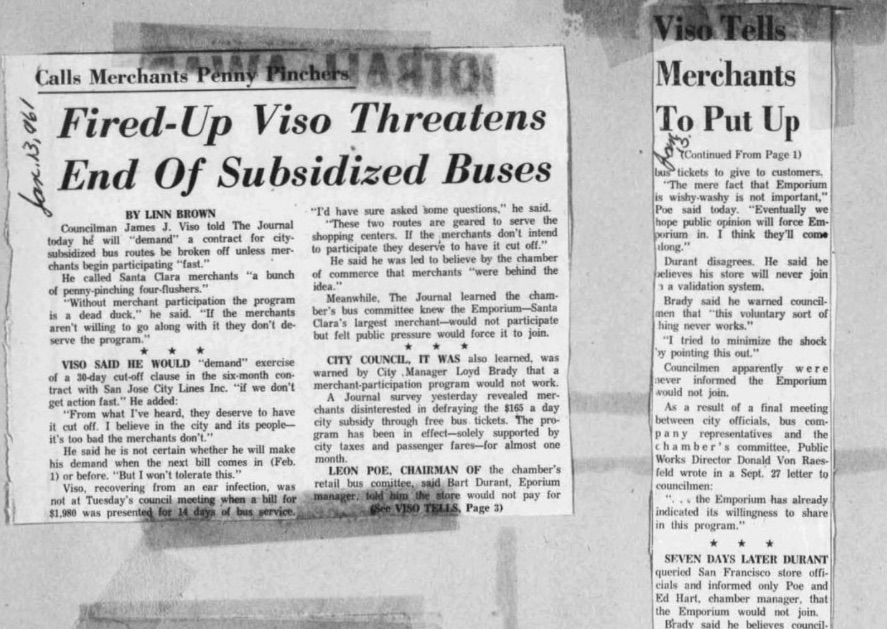

Today, when we think about mass transit the goal is getting people out of their cars. But a half-century ago, Santa Clara attempted to establish an intra-city bus system with the goal of keeping people shopping — and paying sales tax — in town.
In 1960, the City Council started discussing a city-subsidized bus system that would be provided by San José City Lines — the bus system was taken over by what was then the Santa Clara County Bus System in 1972.
The hope was that businesses and the Chamber of Commerce would help subsidize it, with the city underwriting the enterprise, according to a Sept. 27, 1960 report in the Santa Clara Journal.
“The Council had indicated interest in the plan but it referred the proposal to the city’s merchant groups and the Chamber of Commerce for joint financing ideas and route revisions.”
“Some businessmen may seek a ‘free ride,'” said Council Member Jim Viso at a Council meeting, “but far-sighted, aggressive merchants will cooperate.”
Viso also observed that, “If each Santa Clara family spends $15 more monthly in Santa Clara stores, sales taxes will pay for the bus plan.”
The plan rolled out sometime in late 1960 — no contemporary news reports announcing the fact could be found — and it was clear that by Spring of 1961 the buses were running on two routes. But the results weren’t encouraging.
“Three near-empty buses crisscrossed Santa Clara today in search of customers,” Santa Clara Journal reporter Linn Brown wrote on Dec. 15, 1960. One problem affecting the new system was that people didn’t know where the bus routes went.
But the situation was just as bad four months later when reporter Dick Flood wrote in the Santa Clara Journal, “Less than one out of 10 persons given free bus tickets in a Chamber of Commerce test program bothered to use them.”
From the start the enthusiasm of the intended beneficiaries of the bus system — retailers — notably cooled when they were asked to share the costs as well. In January 1961, the Journal reported that, “A survey of Santa Clara merchants today revealed apathy and disinterest in helping to support two new bus lines here.”
A January 1961 Journal editorial said, “One can only come away… sickened by the bold display of selfishness by the majority of the city’s merchants.
“Practically everyone wanted these bus routes, but no one more than the merchants,” the editorial continued. “Yet now that money is involved, no one is willing to pay for his pleasure and the city is left to underwrite the program almost entirely.”
The City’s tab for the mass transit experiment was about $2,000 a month for a service that was collecting $300 to $400 a month in fares. In April 1961, the Council started talking about discontinuing the service.
In July of that year a strike by San José City Lines employees put the nail in the coffin. Council Member Maurice Dullea moved to cancel the service if the strike wasn’t resolved by July 25.
On July 18, 1961 the City Council voted to continue the bus operation but only on a month-to-month basis — a “noble experiment that has proved a failure” Council Member Robert Simons called it. The bus service was to continue until voters could vote on it in a special election, the July 19, 1961 Santa Clara Journal reported.*
On Dec. 20, the Journal reported that Santa Clara’s year-long experiment was “screeching to a halt.” On Nov. 18, 1961 the Council had voted to shutter the service that had cost $47,500 in City subsidies.
An irony of all this is that during these discussions the wrecking ball was at work demolishing Santa Clara’s downtown. This “urban renewal” eliminated the City’s retail core altogether and sent Santa Clara’s neighbors the sales tax revenue that the bus system tried to keep at home.
*Also on the agenda July 18, 1961 was the difficulty the City was having selling its bonds for its share of the San José sewage treatment plant because of its “less-than-best” credit rating and Eichler Homes’ rezoning request for 21 acres on Pomeroy Avenue.
A new Sunnyvale rideshare shuttle will make it easier to get around the city’s Peery…
Former city council member and long-time active member of the Santa Clara community, Debi Davis, passed…
Californians' confidence in their public schools and approval of how Gov. Gavin Newsom and the…
Rotary Park is a neighborhood playground located a block from Santa Clara City Hall. For…
“Maya Gurantz: The Plague Archives,” at the de Saisset Museum on the campus of Santa…
Two people suspected in multiple bank robberies throughout the Bay Area pleaded guilty to the…